Walkabout Tour of Stockholm IV
A Stockholm Walkabout Tour, in the area of Hornsgatan in the South Hills
-
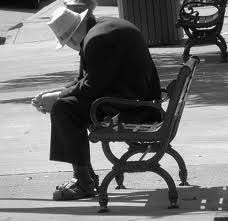 The old man on the bench
The old man on the bench -
-
A Stockholm Walkabout Tour, in the area of Hornsgatan in the South Hills.
-
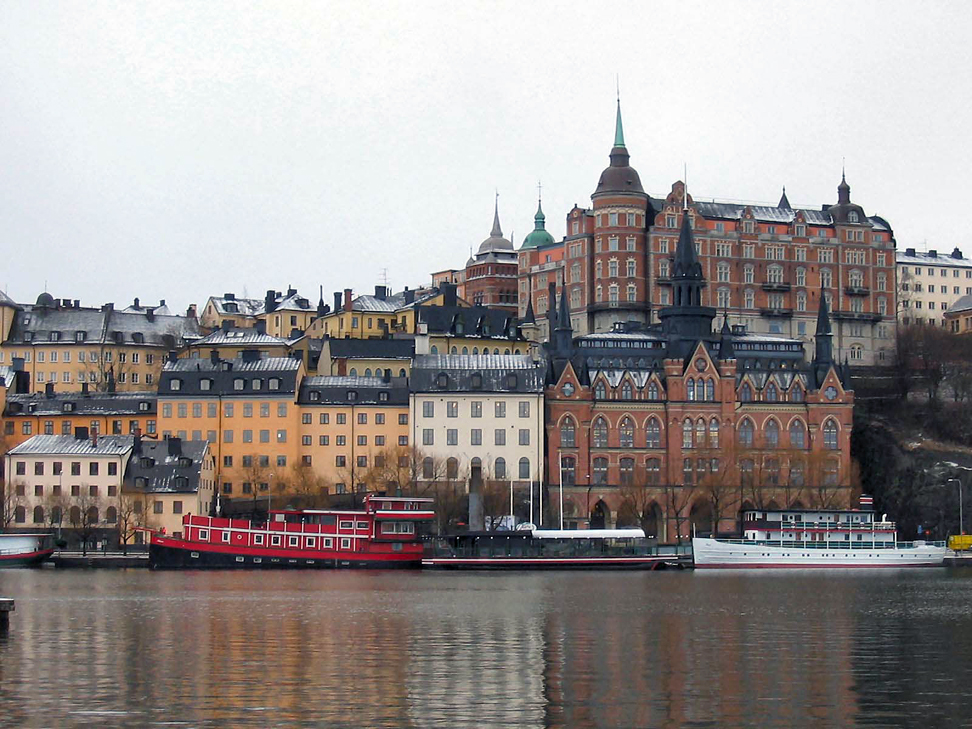 Mälarpalatset (Laurinska Huset) on the west side of Södermalm as seen from the Old Town.
Mälarpalatset (Laurinska Huset) on the west side of Södermalm as seen from the Old Town. -
-
Put on your walking shoes and discovery hat and join me on an informative walkabout tour in the less-known west side of the Stockholm South Hills (Södermalm) at Hornsgatan. (Leif's earlier Walkabouts can be found here: Walkabout Tour of Stockholm I - a stroll through the Old Town, 'Gamla Stan')
-
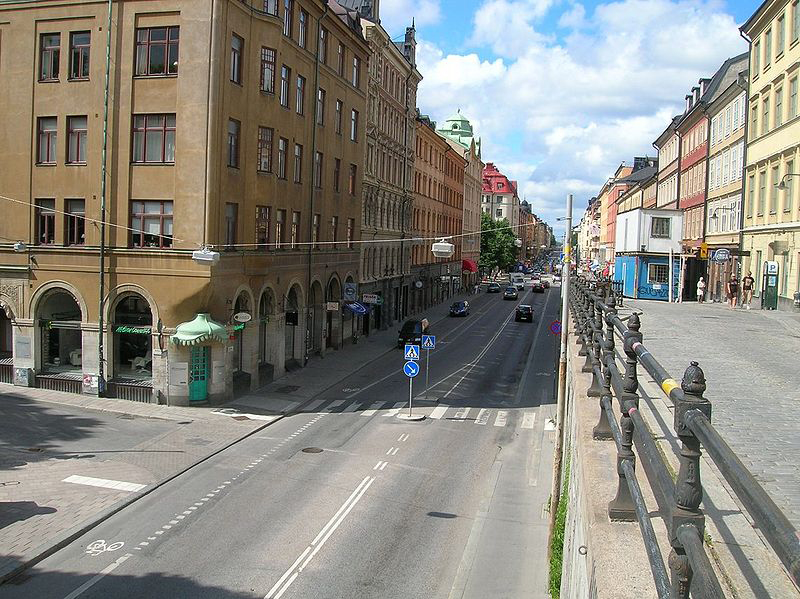 Hornsgatan in Stockholm, Sweden, as seen westward from Hornsgatspuckeln.
Hornsgatan in Stockholm, Sweden, as seen westward from Hornsgatspuckeln. -
Hornsgatan, Kornhamns Torg and Slussen
The street, Hornsgatan, was the street that took you to the Horn (Årsta Strand), which is the name of Södermalm’s western point at Lake Mälaren. Prior to early city planning it was a crooked street passing close by the Church of Maria Magdalene and all the way to the Horn. The street is 2,300 meters (about 1.6 miles) long; it got its name during the 1600s and has many interesting side streets to explore. I will not walk the entire street, only about half of it, and along the walk I will learn more about the hump at “Horngatspuckeln,” Maria Magdalena Church, Carl Michael Bellman and many other interesting things.
Standing at Kornhamns Torg (Grain Square) in the Old Town, I look south and see an imposing building that everyone in Stockholm knows, high up on the Maria Hill: Laurinska Huset, known to locals as Mälarpalatset. The building got its name from its first tenant, the art historian Carl Gustav Laurin. He lived in this house from 1892 until his death in 1942. His apartment in the corner tower had a magnificent view over Riddarfjärden and the Old Town, and was a popular place for the Stockholm cultural elite during the early 1900s. Among his neighbors were his artist friends Hanna and Georg Pauli. Hanna Pauli’s famous painting of Ellen Key (the famous Swedish author and feminist activist) was painted in the couple’s apartment. -
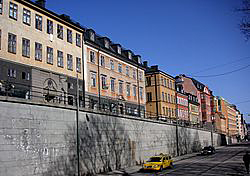 Hornsgatspuckeln (The Hump on Hornsgatan)
Hornsgatspuckeln (The Hump on Hornsgatan) -
On my way I’m passing Slussen (The Locks), an area of central Stockholm, connecting Gamla Stan (Old Town) and Södermalm (South Hills). The area is named after the locks between Lake Mälaren and the Baltic Sea. The locks themselves allow passage between these two bodies of water (of different levels). Slussen also refers to the important traffic-node created in 1935. There is, and has been, an angry, loud and intense debate for how Slussen should look in the future—pitting common people against politicians and some city elite groups.
Just below “Ryssgården” (The Russian Yard) at Slussen, I meet an old man sitting on a bench by the quay, slowly shaking his head pondering.… -
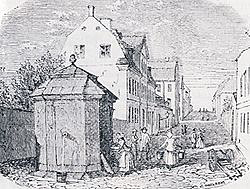 Dauerska Huset, ca 1861
Dauerska Huset, ca 1861 -
Åhh ... så de kämpar alla mina medborgare ...
överallt i min stad kämpar invånarna för att få
behålla sin hemtama miljö ... Varför arbetar stadens
folkvalda så förfärligt mycket mot medborgarna
istället för att samarbeta med dem? Men
vi måste hålla modet uppe kära medborgare ...
dumhet kan aldrig få segra! -
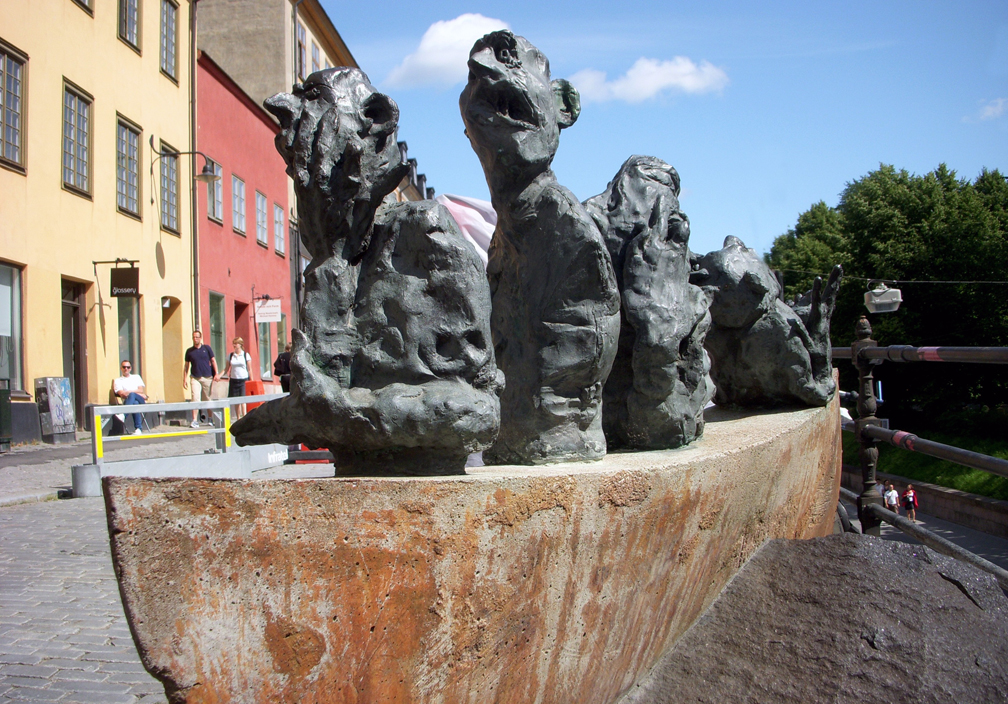 Dårarnas båt (The Fools’ Boat) the sculpture by Sture Collin at Hornsgatspuckeln, Södermalm, Stockholm.
Dårarnas båt (The Fools’ Boat) the sculpture by Sture Collin at Hornsgatspuckeln, Södermalm, Stockholm. -
[Ohh ... how they fight all my fellow citizens ...
everywhere in my city residents struggling to
keep their domesticated environment ... Why
do the city elected struggle against a vast
amount of citizens rather than to work with
them? But we must keep up the spirits dear
citizens ... stupidity can never win!]
(Kyrkgubbens funderingar - http://slussen.ning.com) -
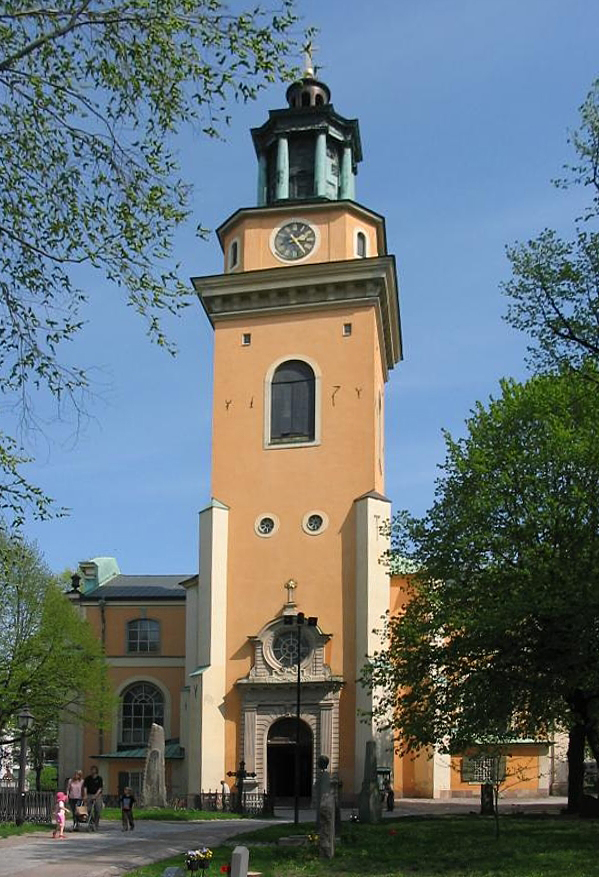 Maria Magdalena Kyrka. Photo: Andreas Ribbefjord/WIkimedia Commons
Maria Magdalena Kyrka. Photo: Andreas Ribbefjord/WIkimedia Commons -
We share a cup of coffee from the man’s thermos, and he shares a little history about Slussen and the Locks with me. “You need to understand that the very soul of Stockholm is changing with all the new and crazy ideas the politicians are coming up with in an endless stream of disagreeable studies.” This is unfortunately very much true across the town.
-
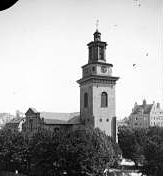 Maria Magdalena Church, Source: Stockholmskällan
Maria Magdalena Church, Source: Stockholmskällan -
The Hornsgatan hump and the 'Fools' Boat'
Leaving the old man behind I soon reach Södermalms Torg (the square of Södermalm) and the beginning of Hornsgatan. Immediately I see an interesting phenomenon called the Hornsgatspuckeln (Hump), which is an elevation to a higher parallel street level of 10 meters (about 33 feet). The “Hump” is the remains of the original Hornsgatan, which was very narrow in the past. The trams could not handle the steep hills and in 1901 they blasted their way through the hump for the new and wider street. -
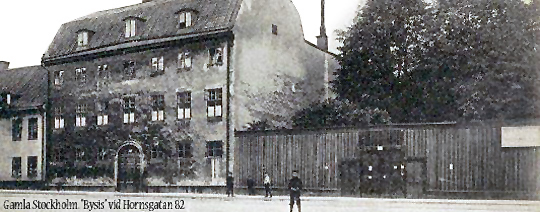 Bysis (Bysättningshäkte—where poets, musicians and other indebted and suspect people were take in custody)
Bysis (Bysättningshäkte—where poets, musicians and other indebted and suspect people were take in custody) -
A lof of Stockholm history disappeared at the same time; the birth place of Carl Michael Bellman, sometimes called “the Swedish Shakespeare,” the Dauererska Malmgården, part of Mary Magdalene Church cemetery as well as all buildings on the south side of the street.
All buildings on the north side were saved. As I am walking over the “hump” I see an interesting piece of art, “Dårarnas båt” (the fools’ boat) by the artist Sture Collin. Maybe, just maybe, this is the image of the modern man ...? -
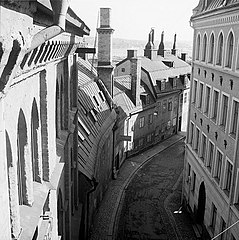 Pryssgränd
Pryssgränd -
Across the street I see the beautiful Maria Magdalena Kyrka (Mary Magdalene Church). The church's history dates back to the 1350s when King Magnus Eriksson, with the permission of Pope Clement VI, had a funeral chapel built on the location and dedicated it to Mary Magdalene. When Gustav Vasa liberated Stockholm in the early 1520s, his troops led by Peder Fredag encamped in the chapel and suffered severe losses when the troops of Christian II of Denmark attacked from the city. This might have been one of the good reasons Gustav Vasa had all churches, monasteries and chapels on the ridges surrounding the city destroyed after the introduction of Protestantism in 1527—including the chapel of Mary Magdalene. However, his son King John III started the construction of a new church on the same spot in 1588, and the church was completed in 1634. The interior of this church is magnificent and must be seen. The famous Swedish troubadour and poet Evert Taube is buried here.
Today is a wonderful day with a lot of sunshine, so I take a short rest on a park bench at the edge of the cemetery. Across from where I sit the street Bellmansgatan appears; another Swedish troubadour was born in this area in 1784. A long time ago there was a building called the “Dauerska Huset,” where Carl Michael Bellman was born. Bellman, a significant Swedish poet and composer, is a central figure in the Swedish song tradition and remains a very important influence in Swedish music. -
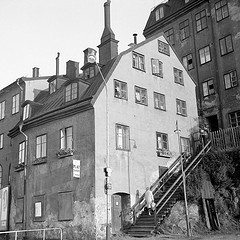 Pryssgränd 10A and part of 10B
Pryssgränd 10A and part of 10B -
I’m smiling by myself as in the same area there was a historic place called “Bysis” (Bysättningshäkte), a sort of prison where poor indebted wretches were held in custody if they had not paid their debt. Many good songs and poetry were coined here as destitute poets became incarcerated behind these walls.
With just a little imagination I could see drunkards sitting here with a piece of cracker bread in their hands. Carl Michael Bellman was known to be one of them, often locked up at Bysis.
Maybe such an institution would be appropriate for modern governments not paying their debt? Today there is a restaurant with the same name, Bysis, at this place.
My next destination was planned to be Mariatorget, but I take a small detour to an area that represent the old “Söders höjder” as I remember it from my younger years. I’m following Bellmansgatan all the way to Pryssgränd, which is located high up on the top of Mariaberget with a stunning view of Lake Mälaren, Old town and the Stockholm Town Hall. Here I’m able to see the old buildings and the architecture of a Stockholm in the past.
Stockholm Stads Museum said in a review: There emerges within the eastern part of Mariaberget the image of a unique set of stone buildings from the 1700s that is of particularly important cultural and architectural interest. The run down buildings were carefully restored in the 1970s for the benefit of us that are visiting today. -
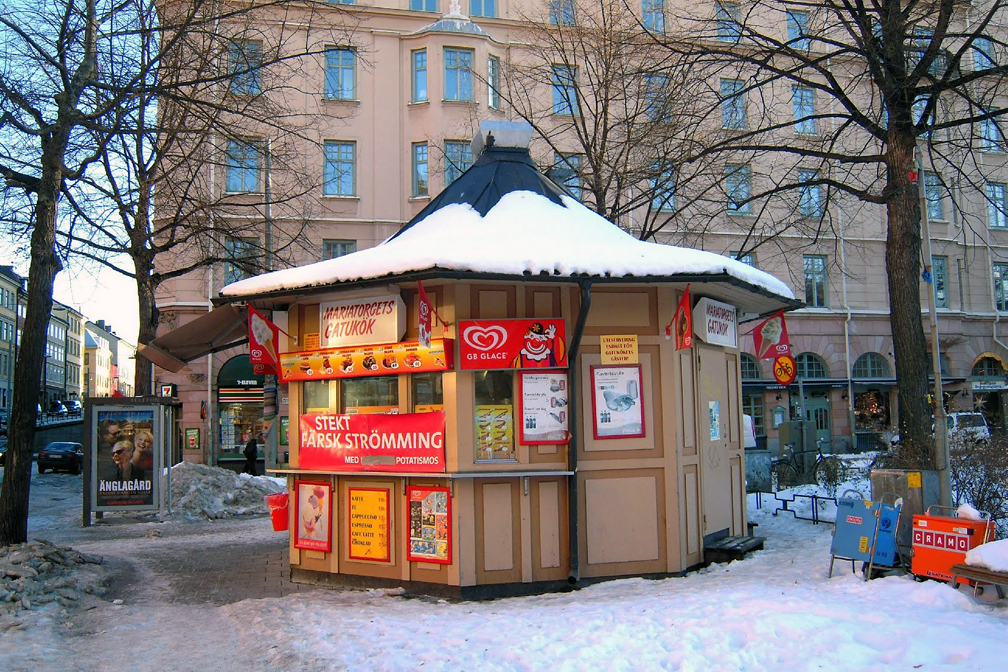 Mariatorgets Gatukök (the snack bar at Mariatorget square)
Mariatorgets Gatukök (the snack bar at Mariatorget square) -
My favorite Stockholm dish
I continue my walk west toward Blecktornsgränd to reach Mariatorget. Here I find my absolute favorite Stockholm dish: the “Strömmings macka” at Mariatorgets Gatukök. Many cities in Europe have a dish that symbolizes their city character. For Stockholm and the South Hills (Söders höjder)it is the “Strömmingmacka” (Baltic Herring on cracker bread with mustard sauce) that best describes the city character. -
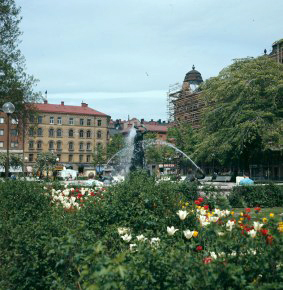 The park at Mariatorget
The park at Mariatorget -
I’m arriving at Mariatorget with its beautiful park, a lot of trees and flowers showing off the beauty to the visitors wishing for a nice afternoon in the sun. As I already mentioned, a large fire burned down several blocks and the Maria church in 1759. And here is the interesting piece of the story—a new square was constructed, named Adolf Fredriks Torg (after the king Adolphus Frederick). The king allowed the use of his name under one condition: that no executions could take place on Adolf Fredriks Torg. During this time period it was not uncommon to have public executions in town squares. This is the square that in 1959 had its name changed to Mariatorget.
-
After spending some time in the park, and visiting a small shop named Söderkryddan to purchase some tea, “Södermalms Blandning,” special for the area and the store, I’m starting my walk back to Slussen to take the bus back to my mother’s place for dinner.
As I’m walking, I’m quietly singing one of the best knows songs I know about Stockholm, written by the Swedish troubadour Evert Taube (loosely translated here): -
See how the whole of Uppland is in flames.
Evening sun burning beyond the Solna forest.
Green verdigris against the violet waves,
Brunnsviksreed stands where the pike splashed.
Far in the South against the faded sky shining
windows shine with gold at Södermalm,
and the palace guard lowers the flag
Stockholm is cooled after today's suffocation. -
Written by Leif Rosqvist, editor of New Sweden Cultural Heritage Society and SRIO newsletters in
Portland, Oregon.
www.newsweden.org
www.swedishrootsinoregon.org
More information is available for the interested:
Stockholms Stads Museum/Stockholmskällan (stockholm stadsmuseum/stockholmskällan)
Stockholms Spårvägs Museum (sparvagsmuseet.sl.se/)
At Wikipedia:
- Carl Michael Bellman
- Ellen Key
- Maria Magdalena Kyrka
- Hornsgatan and Hornsgatspuckeln
The park at Mariatorget -
-
-
